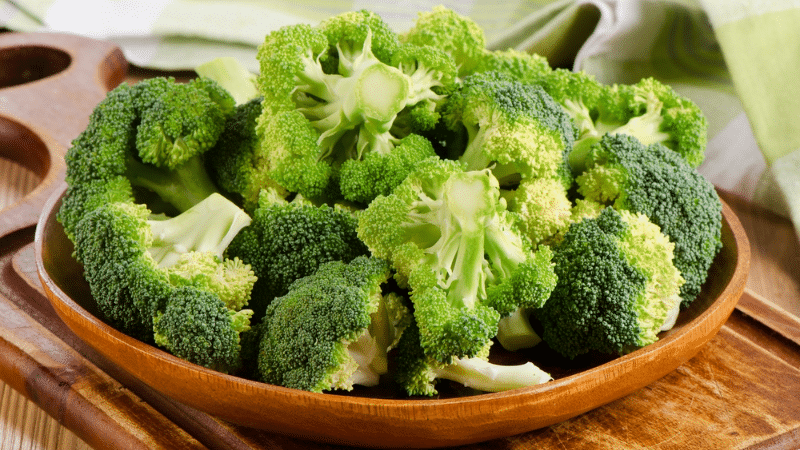
Broccoli has long been a poster child for healthy food. Sadly, it’s also been the target of mockery due to its slightly bitter flavor. Beyond its reputation, the reality is that when introduced early in life, broccoli often becomes a favorite vegetable option for children.
But, what makes it such a paragon of healthy food? For starters, broccoli is a top source of vitamin C and vitamin K. It’s also very rich in vitamin B5, vitamin B6, folate, and potassium. And it provides a good amount of protein, fiber, thiamin, riboflavin, magnesium, manganese, and phosphorus. So, broccoli is fantastic for our bones, our heart, our immunity, our brain, our muscles, our early development, our metabolism, our red blood cells, our overall blood health, and our genes.
But wait! Broccoli is also a great source of lutein and zeaxanthin, two carotenoids that can protect our eyes from macular degeneration due to age, including cataracts. And there’s more! Broccoli is a member of the cabbage family, and as such, it is a great source of sulforaphane, a potent anti-cancer compound that is made by cruciferous vegetables.
We can enjoy broccoli raw with hummus, steamed, roasted, and as an ingredient in pasta or other main dishes, including soup. The popular broccoli soup can be made 100% whole-food, plant-based.
Try our personalized nutrition calculator below to see just how much nutrition you and your family can get from eating broccoli.
Broccoli Nutrition Calculator
Use our personalized nutrition calculator to discover the percentage of daily nutrition needs you and your family can get from eating broccoli.
Nutrition needs vary according to age, sex, and whether women of reproductive age are pregnant or breastfeeding. Fill out the form below for yourself and for your family members to get personalized results.*
* Calculated as a percentage of the Recommended Daily Allowances (RDAs) as established by the U.S. Department of Agriculture and the U.S. Department of Health and Human Services. Based on nutritional information provided by the U.S. Department of Agriculture as an average of multiple broccoli samples.
Tips to Select and Prepare Broccoli
Organic or Not?
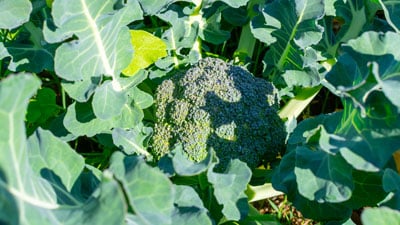
The Environmental Working Group (EWG) tested broccoli for pesticide content and placed it in The Middle of the List in 2025, or in spot 16 of their Full List. This means it was one spot away from making it into The Clean 15 list. So, if you can’t get organic, don’t let that stop you from reaping the benefits of adding broccoli to your family’s meals because conventionally grown broccoli is overall safe.
Sulphoraphane Activation
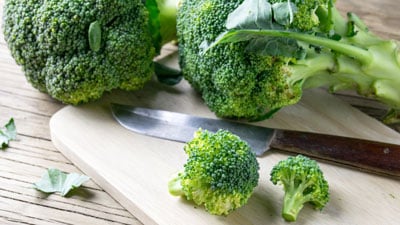
Broccoli is a member of the cruciferous family, so it’s rich in sulforaphane, a strong anti-cancer phytochemical. When broccoli is in distress, it makes sulforaphane out of two compounds: glucoraphanin and enzyme myrosinase. Distress is caused by chewing it raw or chopping it, but it takes up to 40 minutes for sulforaphane to be fully produced. If we eat it raw, it gets formed in our stomach. If we cook it right after chopping it, the heat kills enzyme myrosinase before sulforaphane is made. The fix? Allow your chopped broccoli to sit for 40 minutes before you cook it. Once formed, sulforaphane is heat resistant. Learn more.
Frozen Means Blanched
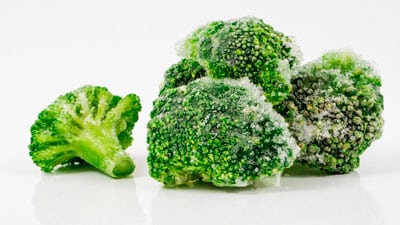
Buying frozen broccoli can seem very convenient, and the nutritional content is really close to what we get when we cook our fresh broccoli. For certain nutrients, the content might even be higher! The problem is that before broccoli gets frozen and packaged, it is blanched, and the heat destroys the enzyme myrosinase, one of the two compounds needed to make sulforaphane. This means that frozen broccoli is not a source of sulforaphane, unless you serve it with another raw cruciferous plant such as raw leafy greens or mustard seeds.
Mustard is a Quick Fix
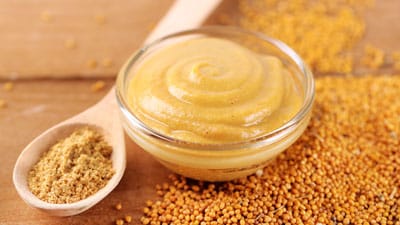
The mustard plant also belongs to the cruciferous family. Therefore, it contains sulforaphane precursor glucoraphanin, and enzyme myrosinase. This means that if we cooked our broccoli right after chopping it, we could add mustard seeds (whole or ground) to give it the active myrosinase it needs to produce sulforaphane out of its own heat-resistant glucoraphanin. Be sure to use the seeds and not commercial mustard sauce that is cooked in the process.
Offer as a Finger Food
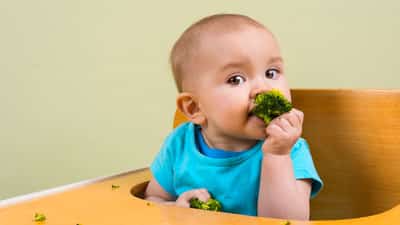
Broccoli can make a wonderful first solid food for babies who are 6 months or older. First, it’s a fantastic source of protein, fiber, vitamin B6 (for brain development), folate, vitamin C, vitamin K, potassium, and more! Second, introducing this food early can help ensure that they like it and continue to eat it throughout their lives. Make sure you give it to them boiled or steamed until soft so it’s safe to eat, and be sure to cut it in the appropriate sizes for their age. Learn more here.
Give to Your Furry Friends

You can also share this healthy vegetable with your furry family members! Raw and cooked broccoli is safe for dogs and cats. But it should be given to them in small amounts (no more than 10% of their daily food) to avoid gastric irritation. Be mindful of not giving them large stalks to prevent choking, though. Especially when it comes to small dogs or cats. Click on these links to read more about feeding broccoli to your dogs and cats.
References
